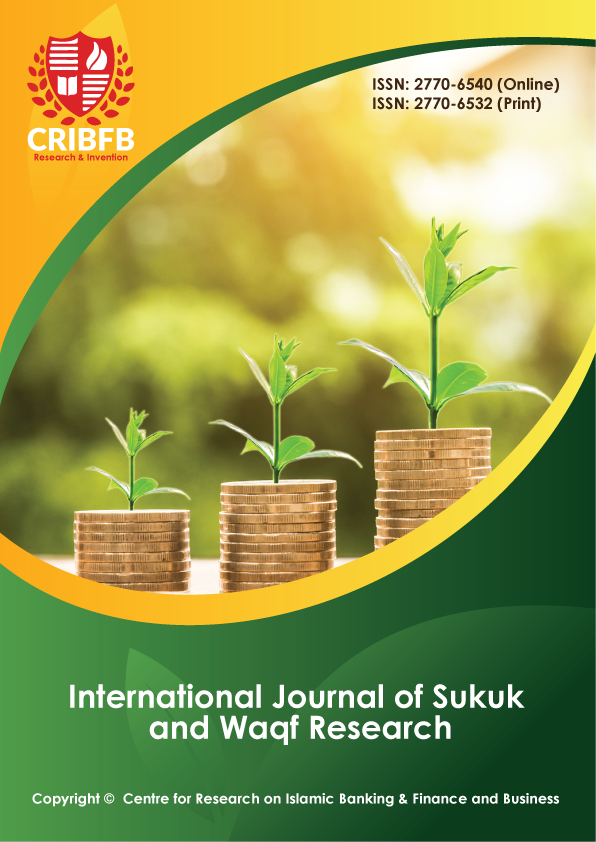MANAGEMENT AND DEVELOPMENT OF WAQF IN AFGHANISTAN
Abstract
This research delves into the importance and pertinence of Waqf in Afghanistan, charting its historical administration across time and emphasizing its customary utilization only for mosques and religious instruction across the country. It examines a number of aspects of Waqf in Afghanistan, such as its historical development of Waqf, the existence of Waqf laws in the country, its evolution throughout time, common difficulties of Waqf, a lack of awareness among the general public even on institutional level, and the required and necessity of updating Waqf customs in the nation. Amidst Afghanistan's ongoing problems with extreme poverty and high jobless rates brought on by years of hostilities and civil war. We believe that there is a chance to revive the Waqf tradition and modify it for use in modern settings. Afghanistan might learn from other prosperous Muslim countries by using Waqf as a tool for economic growth and creating a structure and plan that support charitable endeavors and self-sufficient Waqf-based institutions in the nation. Waqf is well-positioned to assist governmental initiatives in meeting community needs and achieving development goals within Waqf institutions in Afghanistan by fostering social welfare and promotes growth and development of the economy. Afghanistan's Waqf institution is excellent; it can help the government with a wide range of official duties.
JEL Classification Codes: N35.
References
Alias, T. A. (2011). Tax laws affecting Waqf in Malaysia: A comparison with the United Stated and Turkey. 6th UUM International Legal Conference. Pulau Penang.
Hussin, T. M. (2014). Waqf Contribution Opportunity in Malaysia. Retrieved from Inceif Academia: Retrieved from https://www.academia.edu/9071626/Waqf_Contribution_Opportunity_in_Malaysia
Islamic Republic of Afghanistan. (2008-13). Religious Affairs Sector Strategy - Pillar II Good Governance. Afghanistan National Development Strategy (ANDS).
JAWHAR. (2004). Awqaf. Retrieved from Department of Awqaf, Zakat and Hajj - Prime Minister's Department. Retrieved from http://www.jawhar.gov.my/index.php/en/awqaf
JCORP. (2015). Waqaf An-Nur Hospital & Clinics. Retrieved from Waqaf An-Nur Corporation Berhad. Retrieved from http://www.jcorp.com.my/waqaf-an-nur-corporation-berhad-37.aspx
Khan, A. Z. (2010). Extraction of Parcel Boundaries from Ortho-rectified Aerial Photos: A cost effective technique. International Workshop - Spatial Information for Sustainable Management of Urban Areas, (pp. 1-8). Germany. Retrieved June 29, 2015, from http://www.isprs.org/proceedings/XXXVIII/1_4_7-W5/paper/Khan-112.pdf
Kichowchhwi, S. M. (2013). The Future of Afghanistan. Third International Islamic Cooperation Conference on Afghanistan. Istanbul: All India Ulema and Mashaikh Board.
McChesney, R. D. (1973). Waqf under the Afghans. In Waqf in Central Asia - Four Hundred years in the history of Muslim Shrine 1480-1889 (pp. 273-292). New Jersey: Princeton University Press.
Mohammed, N. (2015, June 21). IMF Assisting Afghanistan on Sukuk. Retrieved from Sukuk: Retrieved from http://www.sukuk.com/article/imf-assisting-afghanistan-on-sukuk-4413
Mohmand, A. Q. (2012). The Role of Awqaf in the Development of Islamic Higher Education: the Past, the Present, and Future Prospects. Third international conference on Islam and higher education. Kuantan: Pahang State Foundation. Retrieved from http://www.iais.org.my/e/attach/3rd_ICIHE/3rd_ICIHE_Conference_Programme.pdf
Raissouni, A. (2001). Islamic “Waqf Endowment” Scope and Implications. Rabat, Morocco: ISESCO.
Riaz, U. (2011). State-building in Afghanistan Are Reforms Sustainable. Conflict and Peace Studies, 4(2), 2-11. Retrieved from https://www.google.com.pk/url?sa=t&rct=j&q=&esrc=s&source=web&cd=4&cad=rja&uact=8&ved=0CC4QFjAD&url=http%3A%2F%2Fsan-pips.com%2Fdownload.php%3Ff%3D168.pdf&ei=FFqTVYCFA8StUZKblKAB&usg=AFQjCNEVA5EVUVONm1e9aYbJZTqVr1Ihew&bvm=bv.96952980,d.d24
Sait, S. (2004). Islamic Land Law in Afghanistan: Innovative Land tools and strategies. Kenya: UNHABITAT Global Division.
Sait, S. (2013). Unexplored dimensions: Islamic land systems in Afghanistan, Indonesia, Iraq and Somalia. London: Environmental Law Institute and United Nations Environment Programme. Retrieved June 2015, from http://www.environmentalpeacebuilding.org/assets/Documents/LibraryItem_000_Doc_166.pdf
Wily, L. A. (2003). Land Rights in Crisis: Restoring Tenure Security in Afghanistan. Kabul: Afghanistan Research and Evaluation Unit.
Copyright (c) 2024 Obaidullah Abid, Sarferaz Miakhil

This work is licensed under a Creative Commons Attribution 4.0 International License.





